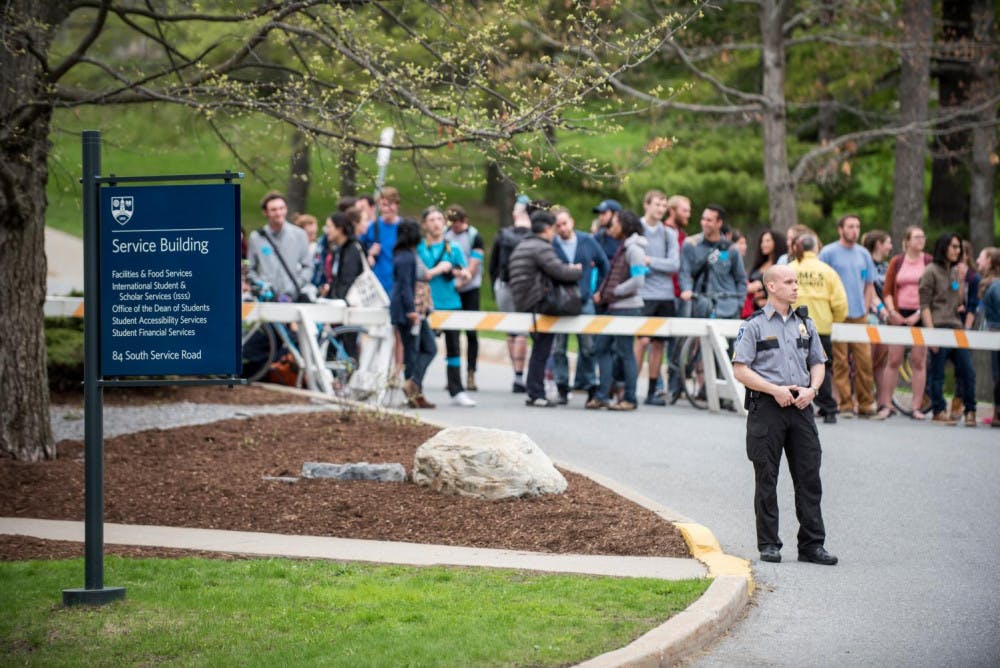A group of 19 students have been placed on probation for the remainder of the academic year, plus an additional two semesters, after the Community Judicial Board found them guilty of violating college policy by participating in the March 2 protests against Dr. Charles Murray.
Probation is a form of unofficial college discipline that consists of a student having a letter placed in their official college file. If a student violates another college policy while on probation they may be subject to official college discipline. The letter remains in the student’s file until graduation.
The students were notified of their punishment on Friday, May 5, the day after they testified before the Judicial Board as a group. This article is based on conversations with several individuals familiar with the situation, who spoke on the condition of anonymity given the sensitive nature of the topic and the fact that the investigation is ongoing.
In a typical judicial hearing, each respondent — the official term for students who have been charged with violating the College Handbook — is allowed to invite a “support person.” However, due to the large number of respondents, the College limited the group to five support persons. The respondents opted to invite Sujata Moorti, professor of gender, sexuality and feminist studies, Jamie McCallum, assistant professor of sociology, Linus Owens, associate professor of sociology, Darién Davis, professor of history, and Patricia Saldarriaga, professor of Spanish.
The hearing, which lasted roughly four hours, started at 6 p.m. on Thursday night. As students entered the hearing, they were provided with a packet of evidence that included photographs, screenshots, links to videos and a description of the charges that were being brought against them.
The meeting began with an opening statement by the respondents. According to one respondent, the students spent roughly 20 hours over the course of four to five days drafting the statement prior to the hearing. They were allowed fifteen minutes to make their opening remarks. Prior to the hearing, the group had chosen a few respondents to read their statement.
Respondents were then given a letter, written by Dean of the College Katy Smith Abbott, that outlined the charges brought against them by the College. They were afforded an opportunity to read the letter prior to the start of the hearing.
Students were facing official college discipline for participating in the events of March 2, which the College viewed as two separate protests. The first is the protest that prevented Murray from speaking after he took the stage. The second is the protest that continued in Wilson Hall as the College live-streamed a conversation between Murray and Allison Stanger, professor of international politics and economics. The group consisted of students who participated in both protests.
Prior to the start of the hearing, students accepted that they violated the “Demonstrations and Protests” section of the College Handbook. The hearing was to determine the type of sanction that they would receive, not to dispute their involvement.
Members of the Judicial Board and respondents then engaged in a question and answer session. Respondents had the ability to discuss their answers to the questions as a group, however, they designated a few specific members to provide the answers.
Per the College’s Judicial Handbook Policy, each respondent then had the opportunity to have a character reference speak on their behalf. All 19 respondents had a character reference.
While a majority of the references were faculty members, some were staff members and others were adults from outside the Middlebury community — 16 references were in attendance and three sent letters. They each had four minutes to speak and were called into the hearing separately. Character references were not allowed to talk about the events of March 2, nor any other information or events that did not directly relate to a respondent’s character.
Respondents were then allowed to deliver a closing statement. According to those involved, the students drafted a rough outline prior to the hearing, however, they were able to adjust their statement throughout the hearing based on the proceedings. The Campus was unable to obtain a copy of the opening and closing statements. Those involved said those statements may be released soon.
Once the hearing concluded, members of the Judicial Board spent over two hours deliberating, according to one person familiar with the situation.
As of press time, individual hearings for those involved with both protests have yet to take place. It is unclear when these hearings will take place and how many students opted for an individual hearing.




